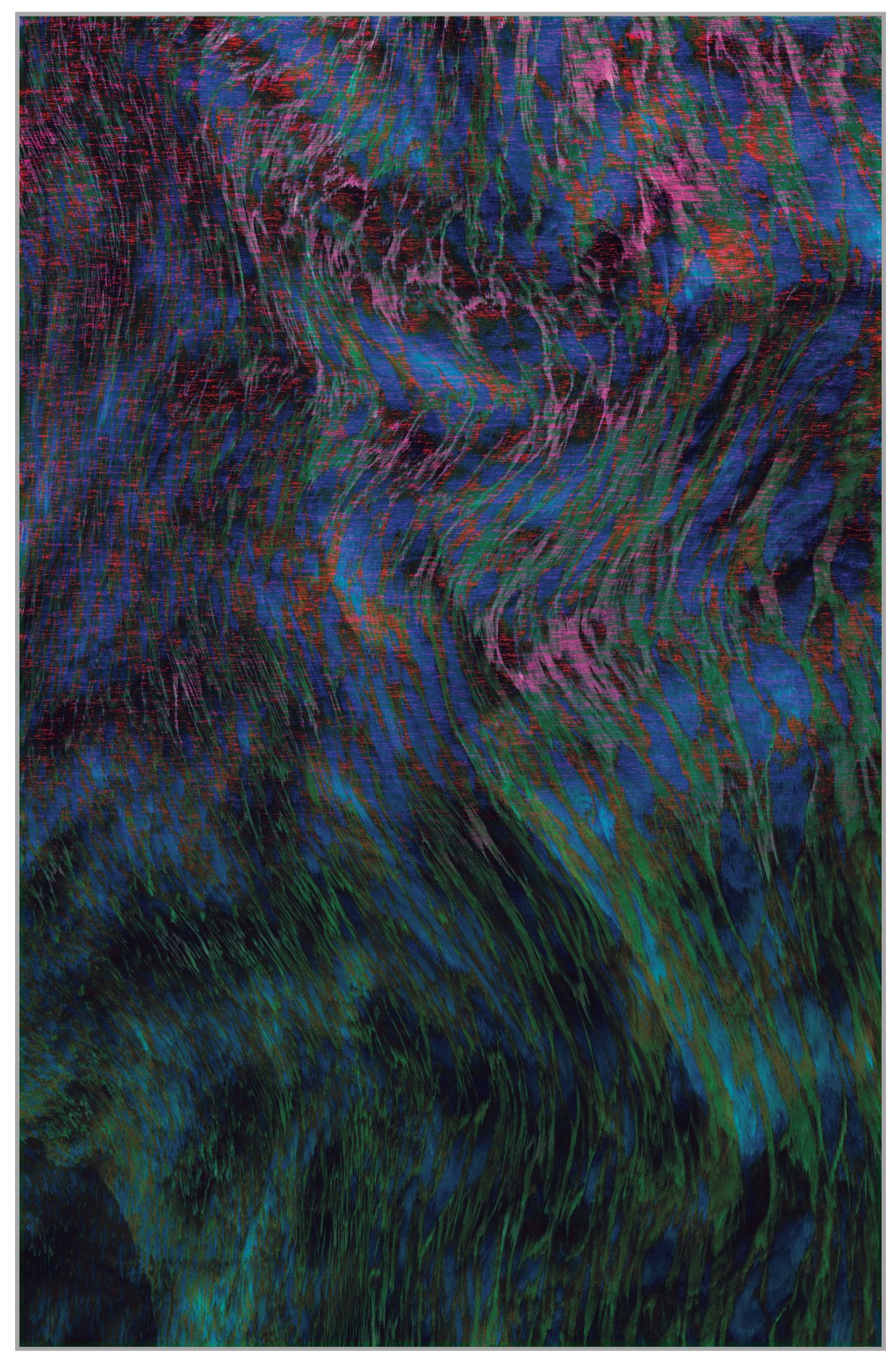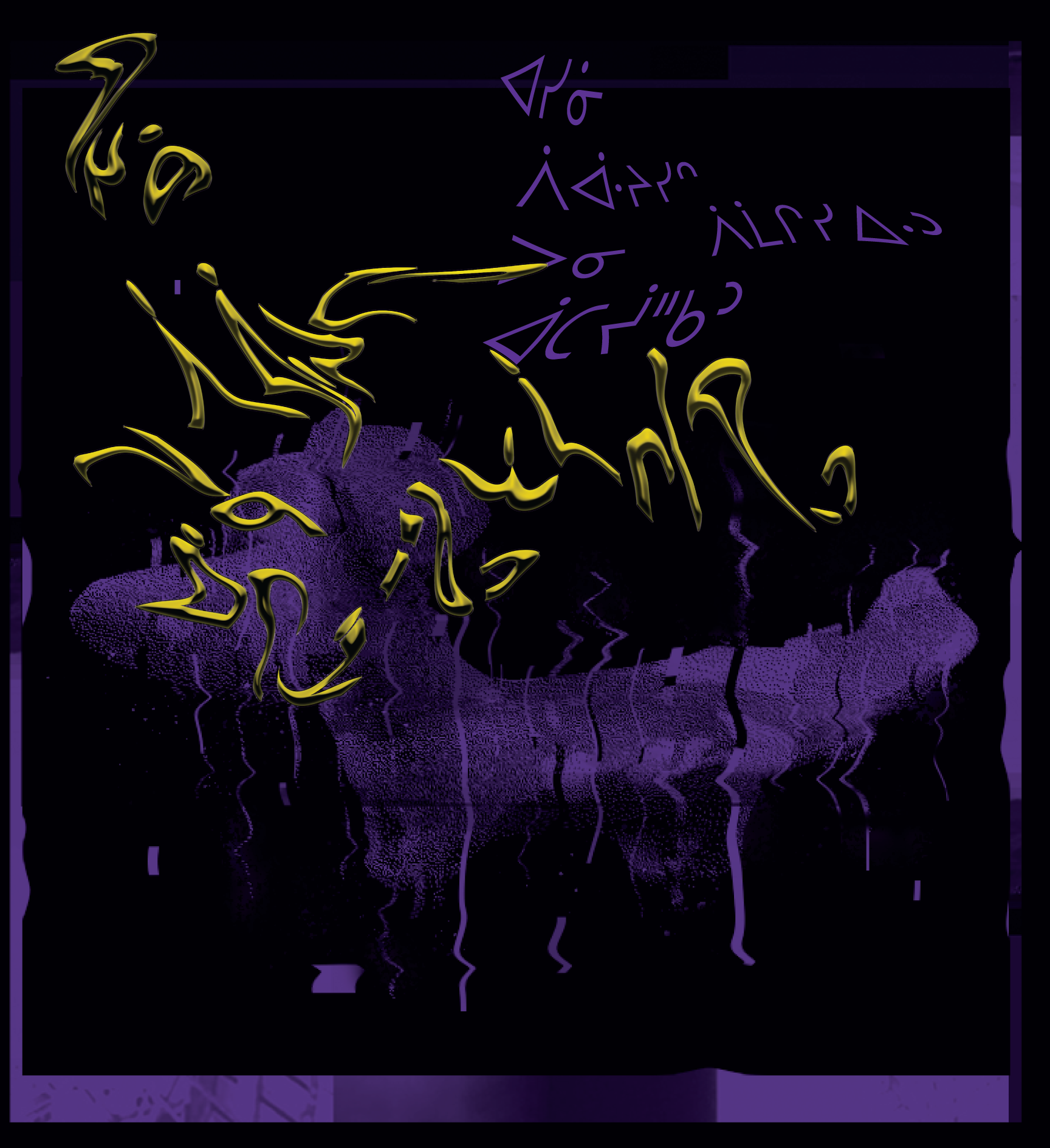

VERBONDEN WEAVINGS
(2028-2256)
This project was started by the government of the region formerly known as Netherlands and ran for 228 cycles until the Second Unification (2256), when the countries within the greater Eurasian tectonic plate merged their government entities. This recently discovered schematic comes from an autonomous digital loom that was constantly weaving at a rate of about 2 meters per day. The pattern being printed represented real-time localized environmental conditions for each day. Evidence suggests that there were about 30 of these autonomous looms set up around the world.
The ancient Buddhist concept of Pratītyasamutpāda (Sanskrit: प्रतीत्यसमुत्पाद), the belief that nothing exists as a single independent entity, was one of the foundational tenets to this practice. Every year, people would gather and ceremoniously walk the length of the weavings (~700m), as a way to reflect on the omnipresent interdependencies between the myriad life forms on the planet. It is believed that this ritual was more meditative and contemplative than celebratory. Not much is known about the demographic who adopted this practice, or how it gained traction, despite it being present in regions around the world.

WEAVING SNIPPET
August 12th 2133
This date marked an iconic disappearance of orange, a color that had been present since the inception of the initiative but that never resurfaced. The orange color (identified as H5 in the code), represented the transmission of harmful particulate matter such as Sulfur Dioxide, Carbon Monoxide, Ground Level Ozone, Nitrogen Dioxide, Aerosols, and a few others. The looms continued weaving for 123 years after this day.
DATA FRAGMENT
(~2115)
D. Sigmona Herund’s team of digital archaeologists have recently recovered a series of data fragments believed to be from the early 22nd century. Pictured here is the most distinguishable of the fragments, in an ancient 3Dimensional format.
The current hypothesis is that this data comes from a time when there were notable efforts to document and immortalize spiritual and cultural artifacts from around the world, which was still being threatened by natural disasters on a regular basis. Some archaeologists believe that the data fragmentation occurred some time much later than the time of recording, when a series of ancient programming languages was retired and many archives are believed to be lost.

Nobody has been able to identify exactly what the data contains. A few distinguishable characters were found scattered throughout what appears to be the metadata for the 3Dimensional shapes. The characters are in the ancient Human language known as Cree, which was spoken in pockets throughout the Central North American plate. The Cree human language has been identified in more contemporary findings, implying efforts of linguistic preservation, but has not been documented since the 24th century.
There is enough evidence to be able to associate these fragments with previously discovered data about spiritual artifacts known as "birdstones". The leading hypothesis suggests that "birdstones" were objects for veneration, used to transfer the souls of the dead to living birds, soul-carriers with a northbound migration.
These fragments seem like they might be a key to better understanding our ancestors from our planet. There is an open call to anyone who might want to run their data mining algorithms to see if clearer findings can be uncovered from this recently discovered vein.
These fragments seem like they might be a key to better understanding our ancestors from our planet. There is an open call to anyone who might want to run their data mining algorithms to see if clearer findings can be uncovered from this recently discovered vein.

These moulds were used to create vessels by growing gourds into them. Once grown, the gourds were dried and used as vessels for spiritual and ceremonial purposes for drinking tea made from local psilocybe varietals. This practice was popularized by the second wave of non-religious spiritualists in the middle of the 21st century, and was adopted by likeminded people globally.
Each vessel shape is unique to a tectonic plate, as an acknowledgement that all living things drift together, along with the outer layers of the earth that we inhabit. Any given vessel shape would be used across the entirety of the tectonic plate, though some minor embellishments were made to represent unique characteristics within sub-geographies, notably within the African and North American plates.
The overall shape for each vessel was defined based on resonant bodies that would resonate at frequencies created by the tectonic shifts.
These vessels were used ceremonially on an annual basis, usually comprising of 7 individuals including a spiritual guide or teacher. Some archaeologists believe that these ceremonies have roots that go back as far as ancient Central American civilizations.
These vessels were used ceremonially on an annual basis, usually comprising of 7 individuals including a spiritual guide or teacher. Some archaeologists believe that these ceremonies have roots that go back as far as ancient Central American civilizations.
 Snapshot of the database containing
Snapshot of the database containingEma mementos generated in the year 2138
in Kagoshima, Japan.
EMA MEMENTO
(~2138)
A new database was discovered containing some of the earliest recorded examples of Ema Mementos. These physical objects, usually measuring no more than 10cm (in height, length or width) contained a DA-PROM (Digital afterlife programmable read-only memory) equipped microchip encased in a biofabricated shell. Each person's Ema Memento was unique, shaped by self-assembly biofabrication over a lattice structure informed by their DNA, and their environment.
Upon death, the deceased's iris provides irreversible authentication for the release of their digital afterlife protocol. Once initiated, this process aggregates their digital footprint. Their personal data and every trace of existence created in the digital space is collected, except for pre-specified protected pieces of data that could be transferred down to families. All of their data is permanently erased, and the data image is then transferred to the microchip, a last vestige of their digital life.
These mementos were given to the families of the deceased, who would ceremonially bring them to an altar at a shrine. Those administering the shrine would burn the mementos in a ceremony that included other rituals, celebrating their entry into the spirit world.
This spiritual end-of-life practice was thoroughly documented in the 4th revision of The Principles of Deep Ecology, which was discovered a few years ago.
This spiritual end-of-life practice was thoroughly documented in the 4th revision of The Principles of Deep Ecology, which was discovered a few years ago.
It was adopted by people around the earth, by those who believed that humans should not continue living algorithmically in a computer after biological death. The virtual detritus is cleared and a humble trail is left behind, leaving nothing but the ultimate death, a glorious transition to the spirit world. These early memento examples set the stage for the collective reflection about the global infrastructure in the virtual realm.

Re-Earthing Lost Data: Spiritual Artifacts
Jerome Tavé
2020
Concept, Digital Art, Print
Jerome Tavé
2020
Concept, Digital Art, Print
We present this series in the form of an archaeological publication from the end of our current millennium, published by a fictional group known as "The Decentralized Network for Data Recovery and Deep Internet Mining". In this narrative, the group is focused on "re-earthing lost data" by searching the depths of abandoned databases and presenting findings from the data fragments they are able to find.
The publication reports on new findings from the global community, and this edition is focused on spiritual artifacts. Recovered evidence of spiritual practices or artifact data, reveal observations about humanity, and how spirituality was being practiced by different groups, both globally, and locally.
Speculating through protopian futurism, we explore ideas around geographical borders, ecology, community, digital afterlife, ceremony, and other spiritual concepts.
The publication reports on new findings from the global community, and this edition is focused on spiritual artifacts. Recovered evidence of spiritual practices or artifact data, reveal observations about humanity, and how spirituality was being practiced by different groups, both globally, and locally.
Speculating through protopian futurism, we explore ideas around geographical borders, ecology, community, digital afterlife, ceremony, and other spiritual concepts.
This piece was exhibited at /room/ by SlashArt in May 2020
Note by Dorothy Santos:
“The Re-earthing Lost Data Since 2880 work by Jerome Tavé piqued my curiosity immediately. The overall aesthetic shows deftness in image-making, symbolic systems, and crafting a narrative found in the genres of science fiction and fantasy. During these uncertain and precarious times, it’s necessary for us to find ways to break from the way we look at systems and objects. His work engages with the tropes of scientific documentation and plays with the deep-seated ideas we have about science, the archive, and empirical knowledge. I found myself craving for more data to be reimagined through Tavé’s collection of stories and images of a distant future of lost data, fragmented typographies, and digital artifacts.”
